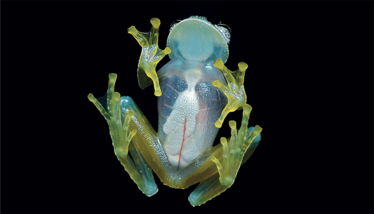The Blood Clot and the Invisible Frog
Groups of tiny glass frogs can sleep on a leaf in daylight and go entirely undetected by predators

Photo by Geoff Gallice / CC BY
Just as H. G. Wells’ Invisible Man found a way to alter his body’s refractive index and render almost every cell* in his body unable to either reflect or absorb light, groups of tiny glass frogs can sleep on a leaf in daylight and go entirely undetected by predators. The glass frog is active at night, during the day – when predators abound – it is dormant, hence its need for superior camouflage. Like the Invisible Man, the glass frog is unable to make all of its cells “invisible” – with its red blood cells being spectacularly stubborn (Wells’ protagonist encountered the same issue, but overcame it through the use of “bleach”!). And yet the frog appears to disappear, so where does it hide them? In its liver, according to Duke University researchers Jesse Delia and Carlos Taboada (1).
By redirecting most of its red blood cells (~89 percent) into its liver, which doubles in size, it gets a little closer to the Invisible Man, increasing its transparency two- to threefold. But with so many red blood cells packed in such close proximity, how does it prevent coagulation?
This excellent question has prompted interest from the drug discovery world. Perhaps the impossibly delicate glass frog holds the secret to anticoagulant medicines for those at risk of venous thromboembolism (VTE). According to the CDC, VTE affects up to 900,000 people in the US alone each year, causing sudden death in one in every four (2).
Extensive research into the glass frog and its extraordinary ability looks set to continue. Now, where did I put that specimen…
*‘I went and stared at nothing in my shaving-glass, at nothing save where an attenuated pigment still remained behind the retina of my eyes, fainter than mist.
- Toboada, et al, ‘Glassfrogs conceal blood in their liver to maintain transparency’, Science, 378, 6626 (2022). doi/10.1126/science.abl6620
- CDC, ‘Impact of Blood Clots on The United States’ (2022). Available at: https://bit.ly/3VKRy7A
Following a Bachelor’s degree in English Literature and a Master’s in Creative Writing, I entered the world of publishing as a proofreader, working my way up to editor. The career so far has taken me to some amazing places, and I’m excited to see where I can go with Texere and The Medicine Maker.



















